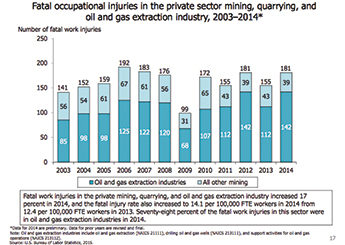Oil and gas industry to ‘step up’ safety in OSHA-backed campaign

Photo: bls.gov
Washington – Oil and gas exploration employers need to “step up” protection for workers at their sites, a new OSHA-backed campaign urges.
OSHA recently launched the 2016 Step-Up for Safety in the Upstream Oil and Gas Industry campaign in partnership with NIOSH and the National Service, Transmission, Exploration and Production Safety Network, a volunteer organization composed of industry operators, contractors and educational institutes.
Workers in oil and gas extraction industries have one of the highest on-the-job death risks in the country, with 142 workers being killed in 2014, according to preliminary data from the Bureau of Labor Statistics.
“Hazardous working conditions are taking the lives of a growing number of workers employed in oil and gas extraction,” OSHA administrator David Michaels said in a Feb. 16 press release announcing the campaign. “This safety step-up will help emphasize the tremendous value in dedicating time during a workday to improve safety and health.”
The step-up campaign consists of a series of events scheduled to take place in February and March around the country, featuring activities such as site inspections and safety trainings. The campaign’s website features toolbox educational materials, including alerts on the hazards associated with hydraulic fracturing and manual tank gauging.
Manual tank gauging involves workers opening hatches to examine fluid levels or take samples. During this process, workers are exposed to gases and vapors, oxygen-deficient atmospheres, and fire and explosion hazards, warns the alert, which was released Feb. 12.
OSHA and NIOSH recommend that employers take a number of steps to minimize the risks associated with manual tank gauging, including:
- Use alternative gauging and sampling means that allow the hatch to stay closed.
- Retrofit tanks with sampling ports.
- Don’t allow employees to work alone.
- Provide workers with – and require them to wear – flame-resistant clothing and impermeable gloves.
From 2010 to 2014, nine workers died during manual gauging or sampling processes, the alert states.
Post a comment to this article
Safety+Health welcomes comments that promote respectful dialogue. Please stay on topic. Comments that contain personal attacks, profanity or abusive language – or those aggressively promoting products or services – will be removed. We reserve the right to determine which comments violate our comment policy. (Anonymous comments are welcome; merely skip the “name” field in the comment box. An email address is required but will not be included with your comment.)

